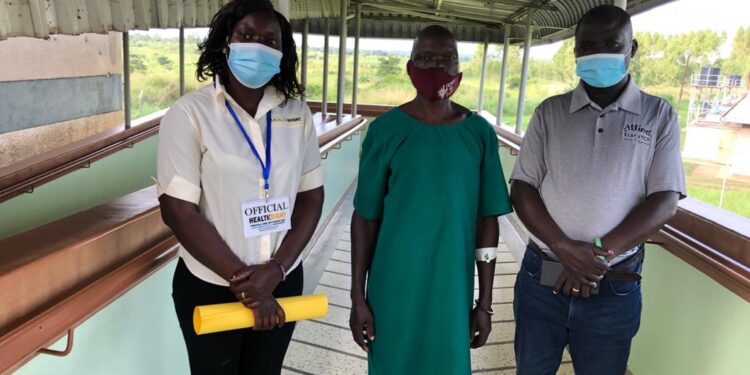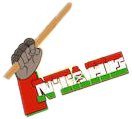Journalists For Justice participated in the joint monitoring visit organised by the Embassy of Ireland in The Hague, and the Trust Fund for Victims, with the assistance of the Embassy of Ireland in Kampala. Journalist Janet Sankale joined the group on its visit to Nwoya and Pader districts and filed this report from Gulu, northern Uganda.
Charles Africa Ocaya sat on a bench on the verandah at Anaka General Hospital in Nwoya District, Uganda, patiently waiting his turn in the operating room.
Looking at him, a stooped figure clad in a green hospital gown, one would never guess that under the calm façade he presents to the world he feels a keen sense of anticipation. And fear too. Because, although the surgery is a welcome gift that will alleviate the constant pain of the injury he has lived with for the past 17 years, it is also a reminder of the fear he felt the day he got hurt, when Ugandan government forces struck at a Lord’s Resistance Army (LRA) camp in the bush in the northern part of the country, where he had been held in captivity for six years.
The memories of the bullets flying on that fateful day, the searing pain as a piece of shrapnel pierced his Achilles tendon, and the agony of his serious injury being treated at a bush “hospital” using herbs appear fresh, as if to emphasise the contrasting circumstances surrounding the care of that wound in the present.
Ocaya is not a stranger to fear. The war that Joseph Kony’s Lord’s Resistance Army has wedged for more than 20 years might have ended in northern Uganda, when the rebel group was dislodged in 2006 and stopped operating there, but for Ocaya, the memory of his abduction and enslavement remains fresh in his mind. He still remembers being captured by LRA soldiers as a terrified 10-year-old boy who had no idea what was happening. He still remembers the agony of his six years in captivity, living in makeshift camps and with the constant fear of attack by the Ugandan government forces, and the even greater terror of the LRA’s raids on civilians in the area.
He appears reluctant to dwell on that horrific period in his life, answering questions abruptly and briefly. “I was only 10 years old when I was abducted and lived close to six years in captivity during which I was subjected to many forms of torture including beatings, carrying loads, and attending to those who got injured during the war.”
Despite prompting, he does not elaborate. But his tone is desolate, for he still remembers the fear.
Ocaya, who hails from Apaa village in Amuru District in northern Uganda, is lucky. He is a survivor of the brutal campaign by the LRA in northern Uganda between 1987 and 2006, and which continues to this day in other countries in the region, particularly the Democratic Republic of the Congo and the Central African Republic. The UN estimates that the LRA is responsible for more than 100,000 deaths. Some 60,000-100,000 children and adults have been abducted and more than 2.5 million people have been displaced from their homes between 1987 and 2012.
So many years later, Ocaya sometimes finds it difficult to believe that he can wait peacefully in a safe place for medical treatment without fear of an imminent attack. He can finally start to heal, both physically and psychologically under the care of the staff at Anaka hospital.
Ocaya is one of the beneficiaries of the assistance programme of the Trust Fund for Victims (TFV) in Uganda, started in 2008 to assist victims in the conflict-affected region. The fund has dealt with victims of conflict, including medical and psychological rehabilitation, as well as livelihood support.
Health Right International (HRI), through funding from the TFV, has been providing physical, psychological, and material rehabilitation support to LRA war victims since 2019. HRI has been operational since 2006 in West Nile, and northern and eastern Uganda. It has been working closely with Anaka General Hospital, one of the surgical camping sites in Nwoya district, offering physical rehabilitation to victims of the conflict.
Nwoya is one of the newer districts in northern Uganda and is estimated to have a population of 54,000 people. It borders Amuru and Gulu districts. Just like Gulu, it was for many years an epicentre of the LRA insurgency. It is a remote area with poor access to healthcare. Anaka hospital was a refuge to many who fled their homes during the war. At one time it was attacked and vandalised by the LRA. The hospital was renovated in 2015.
Speaking to Journalists For Justice, Dr Lapat Jolie Jo, a gynaecologist working in Anaka, said the hospital hosts victims of LRA who come to seek physical rehabilitation.
“We offer both consultation and medical treatment and this camp aims to provide surgical intervention for victims who need surgery,” the doctor said.
He added that teams of doctors and health workers visit the community in Nwoya and neighbouring districts to offer screening services at their health centres and identify surgery candidates. All other medical investigations are sent to Anaka hospital.
The hospital also offers gynaecological services and surgical operations to women who have fistulas, chronic pain, and other injuries due to sexual and gender-based violence suffered during the period of the LRA insurgency.
According to HRI, the hospital has directly impacted the lives of 8,157 people (5,291 female and 2,866 male), who have benefited from physical rehabilitation.
Some 1,386 survivors of the LRA war (842 female and 15,390 male) have had reconstructive and corrective surgery, while more than 60,000 individuals living within the project catchment area have attended sensitisation meetings and acquired knowledge about the physical and psychological services being offered.
And that is how Ocaya came to hear about the services at Anaka hospital.
“It came to my attention that HRI, during one of its community outreach operations, was registering victims in the community who required surgical services due to bullets stuck in their bodies during the war. I was in pain, suffering for all these years in silence, not knowing I could get help,” he said.
He registered with the organisation in March 2022 and is happy to finally get the treatment he needs.
For the peasant farmer with two wives and seven children, life holds much hope and promise as his prepares to resume the “normal” life he has not enjoyed since his abduction by LRA soldiers more than 20 years ago; life without a limp and constant pain.
The LRA started operating in 1987 in northern Uganda among the ethnic Acholi communities, which had suffered serious abuses at the hands of successive Ugandan governments in the turbulent 1970s and 1980s. In its heyday, the group abducted and killed thousands of civilians in northern Uganda and mutilated many others by cutting off their lips, ears, noses, hands, and feet.
In 2004, after many unsuccessful attempts to disband it both in Acholiland and the neighbouring states of DRC, Sudan, and CAR, the Ugandan government referred the situation in the northern region to the International Criminal Court (ICC) to investigate crimes under the Rome Statute on its territory. The ICC issued arrest warrants against LRA supremo Kony and four other senior leaders in 2005 for war crimes and crimes against humanity.
Former child soldier and former LRA brigadier Dominic Ongwen was convicted of 61 counts of crimes against humanity and war crimes in February 2021. In May of that year, Ongwen was sentenced to 25 years imprisonment. He has appealed the conviction and sentence, and the decision is currently pending before the Appeals Chamber at the ICC.
The case entered the reparations phase in May 2021, with solicitation of reparation observations.
While the ICC is responsible for investigating and prosecuting a criminal case involving the crimes of genocide, war crimes, and crimes against humanity, the mission of the Trust Fund for Victims is to respond to the harm resulting from the crimes under the jurisdiction of the ICC.







